
The Institute’s Marketing Manager, Hester McQueen, interviews Ian Bateman OBE FRSA FRSB as he prepares to address the Institute’s forthcoming National Conference, Trees, People and the Built Environment 4.
Who is Ian Bateman OBE FRSA FRSB
Ian Bateman OBE FRSA FRSB is a Professor of Environmental Economics and Director of the Land, Environment, Economics and Policy Institute (LEEP) at the University of Exeter Business School. Ian has a wide array of research interests revolving around the issue of ensuring sustainable wellbeing through the integration of natural and social science knowledge within decision making and policy. Particular interests lie in the fields of quantitative analysis, integrated modelling and the valuation of non-market benefits and cost. He has been or is advisor or consultant to Defra, DfT, DoH, NICE, OECD and numerous other bodies.
Tell us about your presentation
I will be discussing the ‘natural capital approach’ – the way in which policies such as the UK Government’s 25 Year Environment Plan (25YEP) and the HM Treasury ‘Green Book’ public sector spending guidelines incorporate the natural environment and the benefits it provides within decision making. A key element of this will be looking at all of the various benefits and costs (including those arising outside marketed goods) of changing the environment and how these can be reflected in economic values. I will be showing how this leads us to realise the importance of ensuring we have the right treescape in the right place.
Why is your presentation important for our conference?
Because what determines the right location and right types of treescapes is not just the natural and physical science of trees, but their connection to and benefits for people. By linking science and socio-economics together we discover a very strong argument for planting trees.
What are the biggest challenges facing green infrastructure?
Ensuring that investments consider both science and people, and delivering the best value for money given available resources.
What impact is your work making in the built environment?
I am a member of the UK Natural Capital Committee advising the Government on the value of natural capital. I hope this advice is having some effect via the 25YEP and Green Book and forthcoming legislation.
How do we build resilient places for us to live in for the future?
- Identify the most important needs for people
- Consider multiple alternative strategies for addressing those needs
- For each alternative strategy link natural and physical; science to socio-economic analysis
- Use this to appraise all the benefits and costs of each alternative
How did you get into your role?
Mainly luck, great parents, crazy work ethic, unusual circumstances and a few pieces of great advice – but mainly luck.
The triennial conference, Trees, People and the Built Environment is a unique gathering of built and natural environment professionals, working towards the shared goal of enhancing green infrastructure. The acclaimed urban trees research conference will return to the University of Birmingham on 22-23 April 2020. It is a must-attend event for those who work in urban landscapes or the built environment. Buy your early bird ticket before 1 December 2019 and save £66.






